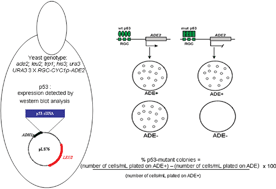Evaluation of heavy metal toxicity in eukaryotes using a simple functional assay
Abstract
Although carcinogenesis caused by metals has been intensively investigated, the mechanisms of action, especially at the molecular level, are still unclear. This work aimed to investigate Cd2+, Cu2+, Ni2+, Cr3+, and Zn2+ mutagenicity and its relationship with oxidative stress. We have applied the Functional Assay for the Separation of Alleles in Yeast (FASAY) with only minor modifications to detect p53 defects caused by metals. In this method, human p53-coding gene (TP53) expressed in Saccharomyces cerevisiae activates transcription of the ADE2 reporter gene. Yeast cells, expressing p53, were exposed to increased concentrations of metals and, then, plated on media supplemented or not with

- This article is part of the themed collection: Third International Symposium on Metallomics, Münster, Germany 2011

 Please wait while we load your content...
Please wait while we load your content...